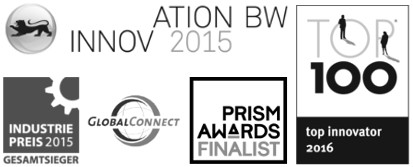WS400-UMB Smart Weather Sensor
Compact all-in-one weather sensor for measurement of temperature, relative humidity, precipitation intensity, precipitation type, precipitation quantity and air pressure.
From the WS product family of professional intelligent measurement transducers with digital interface for environmental applications. Integrated design with ventilated radiation protection for measuring: Air temperature, relative humidity, precipitation intensity, precipitation type, precipitation quantity and air pressure. One external temperature sensor is connectable.
- Temperature, relative humidity, precipitation intensity, precipitation type, precipitation quantity and air pressure
- NTC/T, Capacitive/RH, MEMS capacitive/Pressure, 24 GHz Doppler radar/Precipitation
- Compact all-in-one weather sensor, low power, heater, aspirated radiation shield, maintenance-free operation, open communication protocol
- RS485 with supported protocols UMB-Binary, UMB-ASCII, Modbus-RTU, Modbus-ASCII, XDR and SDI-12
- 8369.2, 8369.1
Advantages of the Smart Weather Sensor WS400
- All-in-one housing concept of a compact weather sensor combining several measurement parameters in one housing with only one cable connection
- Built-in data pre-processing, universal interfaces and selectable output protocols
- Compatible with many commercially available Met/HydroMet dataloggers and PLS systems thanks to an open communication protocol
- Maintenance-free operation – no moving parts that can wear out
- Suitable for all climate zones; also for solar-powered automatic meteorological stations
- Ventilated temperature and humidity measurement according to WMO guidelines
- Integrated heater that can be switched on if there is danger of frost
Examples of use of the Smart Weather Sensor WS400
The robust and maintenance-free smart weather sensor WS400 is designed for professional meteorological applications in all climate zones. It delivers reliable data, even in extreme ambient conditions.
Examples of use:
- Weather observation for road and traffic control systems
- Automatic weather station / Automatic weather sensor (AWS)
- PV-Monitoring / Solar Monitoring on photovoltaic farms
- Hydro-meteorological stations
- Weather observation for building automation
- Weather stations at airports, marinas and onboard ships
- Integration into various other systems/solutions, where environmental data is needed...
Product variants - Smart Weather Sensor WS400
The Smart Weather Sensor WS400 is available in three product variants because of special laws concerning the use of radar technology in the UK and the USA, which is part of the precipitation measurement of the WS400.
- Smart Weather Sensor WS400-UMB - version: Europe (Article no. 8369.2)
Frequency range: 24.150 GHz – 24.250 GHz - Smart Weather Sensor WS400-UMB - version: North America (Article no. 8369.1)
Frequency range 24.075 GHz – 24.175 GHz
|
|
Firmware - WSXXX
For WSXXX device versions 1 - 29 (see serial number) / Für WSXXX Geräteversionen 1 - 29 (siehe Seriennummer)
|
Firmware - WSXXX v70
For WSXXX device versions ≥30 (see serial number)
|
|
|
|
|
|
|
|
| General | |
| Dimensions | Ø ca. 150 mm, height ca. 280 mm |
| Weight | Approx. 1.3 kg |
| Interface | RS485, 2 - wire, half - duplex |
| Power supply | 11 …. 32 VDC |
| Power supply | 5 … 11 VDC (electronics with limited precision of measurements) |
| Power supply | 24 VDC +/- 10% (heater) |
| Power consumption | 20 VA (heater) |
| Frequency range | 24.150 GHz – 24.250 GHz (Europe) 24.075 GHz – 24.175 GHz (North America) |
| Frequency range | 24.150 GHz – 24.250 GHz (Europe; Article no. 8369.2) 24.075 GHz – 24.175 GHz (North America; Article no. 8369.1) |
| Operating temperature | -50...60 °C (with heater) |
| Operating rel. humidity | 0...100 % RH |
| Protection level housing | IP66 |
| Mast mounting suitable for | Mast diameter 60 - 76 mm |
| Temperature | |
| Principle | NTC |
| Measuring range | -50 ... 60 °C |
| Unit | °C |
| Accuracy | ±0.2 °C (-20...50 °C), otherwise ±0.5 °C (>-30 °C) |
| Relative humidity | |
| Principle | Capacitive |
| Measuring range | 0 ... 100 % RH |
| Unit | % RH |
| Accuracy | ±2 % RH |
| Air pressure | |
| Principle | MEMS capacitive |
| Measuring range | 300 ... 1200 hPa |
| Unit | hPa |
| Accuracy | ±0.5 hPa (0...40 °C) |
| Precipitation (liquid) | |
| Droplet size | 0,3 … 5 mm |
| Detection sensitivity | 0,01 mm/h |
| Particle velocity | 0.9 ... 15.5 m/s |
| Precipitation types | rain/ snow |
| Solid precipitation | 5.1 ... ~30 mm |
| Intensity range | 0…200mm/h |
| Intensity resolution | 0.01 mm/h |
| Amount resolution | 0.1 mm |
| Accuracy | 20 % under laborary conditions |
| Reproducibility | Typical >90 % under laborary conditions |
WS product family: Communication after protocol change
How to communicate with a WS-Sensor and the UMB-config-Tool if the protocol was changed for example to Modbus or SDI-12?
After a Reset ( switching On/Off the sensor) every WS-Senor will start up for the first 5 seconds in UMB-protocol and the standard baud rate of 19200Bd. Independend to the configured protocol and baudrate settings of the WS-Sensor.
In this first 5 Seconds you will be able to connect via UMB-config-Tool to the WS-Sensor after this first command was send the UMB-protocol will stay for 10 minutes after that it switches back to the original configured protocol. This Time will always be extended to 10 minutes if a new UMB command was send.
WS product family: SDI-12 wiring plan for Device version >= 42
How to connect a WS-sensor with a device version >= 42 (hardware version >=14) to a SDI-12 system?
The wiring plan has changed compared to the wiring plan of older WS-Sensor device versions.
The new wiring plan is:
- +VDD = brown
- GND = white
- SDI12_Signal = yellow
- SDI12_GND = white
This is also mentioned as a note in the latest WS-sensor manual in the section 8 Connections




























